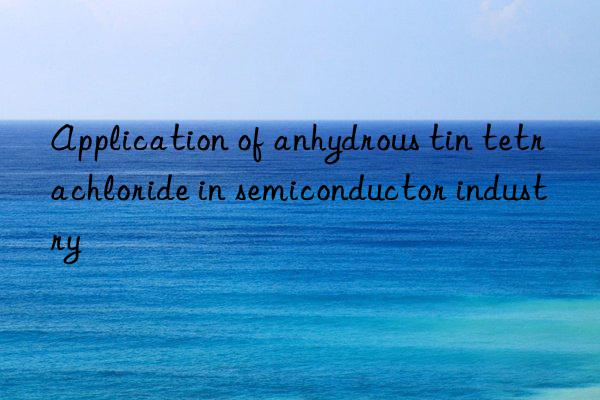
Anhydrous tin tetrachloride (SnCl4), as an important inorganic compound, plays a key role in multiple industries, especially in the semiconductor industry. Its chemical stability, reactivity, and volatility at high temperatures make it one of the key precursors for manufacturing semiconductor materials. The specific applications of anhydrous tin tetrachloride in the semiconductor industry are discussed in detail below.
Semiconductor thin film deposition
One of the notable applications of anhydrous tin tetrachloride in the semiconductor industry is as a metal source during thin film deposition processes. Anhydrous tin tetrachloride can be used to form high-quality tin-based films through techniques such as chemical vapor deposition (CVD), atomic layer deposition (ALD), or physical vapor deposition (PVD). These films play a vital role in electronic devices, optoelectronic devices and solar cells.
Chemical Vapor Deposition (CVD)
In the CVD process, anhydrous tin tetrachloride is used as a tin source and reacts with hydrogen, ammonia or other reactive gases at high temperatures to form a thin film of metallic tin or tin compounds. Such films can be used to make various types of semiconductor devices, such as field-effect transistors (FETs), metal-insulator-metal (MIM) capacitors and microelectromechanical systems (MEMS) components.
Atomic Layer Deposition (ALD)
ALD is a technology for precisely controlling film thickness and is particularly suitable for applications requiring extremely high uniformity and extremely thin layers. Anhydrous tin tetrachloride can be used to deposit ultra-thin and highly uniform tin-based films in the ALD process, which is crucial for manufacturing high-performance nanoscale electronic devices.
Preparation of tin-based alloy
In semiconductor packaging and interconnection technology, anhydrous tin tetrachloride is also used to prepare various tin-based alloys, such as tin-lead alloy (Sn-Pb), lead-free solder (such as Sn-Ag-Cu), etc. . These alloys have good welding properties and reliability and are critical for the packaging of semiconductor chips and the assembly of circuit boards.
Photovoltaic technology
In the field of photovoltaics, anhydrous tin tetrachloride can be used to make precursor solutions for perovskite solar cells. Perovskite materials have received widespread attention due to their excellent photoelectric properties, and anhydrous tin tetrachloride helps improve the quality and stability of perovskite films, thereby improving the efficiency and lifespan of solar cells.
Other applications
In addition to the above applications, anhydrous tin tetrachloride also plays a role in etching, cleaning and passivation in the semiconductor manufacturing process. It can help remove unwanted layers of material, clean surfaces, and form protective films to enhance the performance and durability of semiconductor devices.
Safety and Handling
It is worth noting that anhydrous tin tetrachloride is highly corrosive and toxic, so its use in the semiconductor industry requires strict safety measure. Proper personal protective equipment and ventilation are essential to prevent inhalation of its vapors or contact with skin and eyes.
In short, anhydrous tin tetrachloride plays a multi-faceted role in the semiconductor industry, from thin film deposition to alloy preparation to the application of photovoltaic technology, all reflecting its indispensable value. As semiconductor technology continues to advance, the application scope and importance of anhydrous tin tetrachloride is expected to continue to expand.
Please note that this article provides an overview of the application of anhydrous tin tetrachloride in the semiconductor industry. Specific technical details and developments may require reference to new scientific research documents and technical reports. Additionally, when handling any chemical, safety always comes first and all applicable safety regulations and guidelines must be followed.
Further reading:
bismuth neodecanoate/CAS 251-964-6 – Amine Catalysts (newtopchem.com)
stannous neodecanoate catalysts – Amine Catalysts (newtopchem.com)
polyurethane tertiary amine catalyst/Dabco 2039 catalyst – Amine Catalysts (newtopchem.com)
N-Methylmorpholine – morpholine



 微信扫一扫打赏
微信扫一扫打赏
